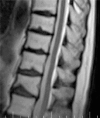Syndromes with chronic non-bacterial osteomyelitis in the spine
- PMID: 27407266
- PMCID: PMC4847283
- DOI: 10.5114/reum.2015.57639
Syndromes with chronic non-bacterial osteomyelitis in the spine
Abstract
Chronic non-bacterial osteomyelitis (CNO) has been known for over of 40 years. It is an underrecognized entity due to the low number of described cases and poor propagation awareness of the problem. Chronic non-bacterial osteomyelitis is usually confused with infectious spondylodiscitis or malignant lesions, both primary and metastatic. Failing to consider CNO as one of possible lesions of the spine among an array of differential diagnoses may lead to a prolonged ineffective treatment increasing treatment-related morbidity. In this paper the authors describe these two syndromes, with a possible autoimmune background - chronic recurrent multifocal osteomyelitis (CRMO) and SAPHO syndrome - that include CNO being among the manifestations. The authors present the spinal symptomatology of CNO for both syndromes published so far to help spine clinicians organize the information for better usage in everyday clinical practice.
Keywords: CRMO; SAPHO syndrome; non-bacterial inflammation; osteomyelitis.
Figures




References
-
- Giedion A, Holthusen W, Masel LF, Vischer D. Subacute and chronic “symmetrical” osteomyelitis. Ann Radiol (Paris) 1972;15:329–342. - PubMed
-
- Sasaki T. A case of osteomyelitis of the bilateral clavicles associated with pustulosis palmaris et plantaris. Rinsho Seikeigeka. 1967;2:333–337.
LinkOut - more resources
Full Text Sources
Other Literature Sources
